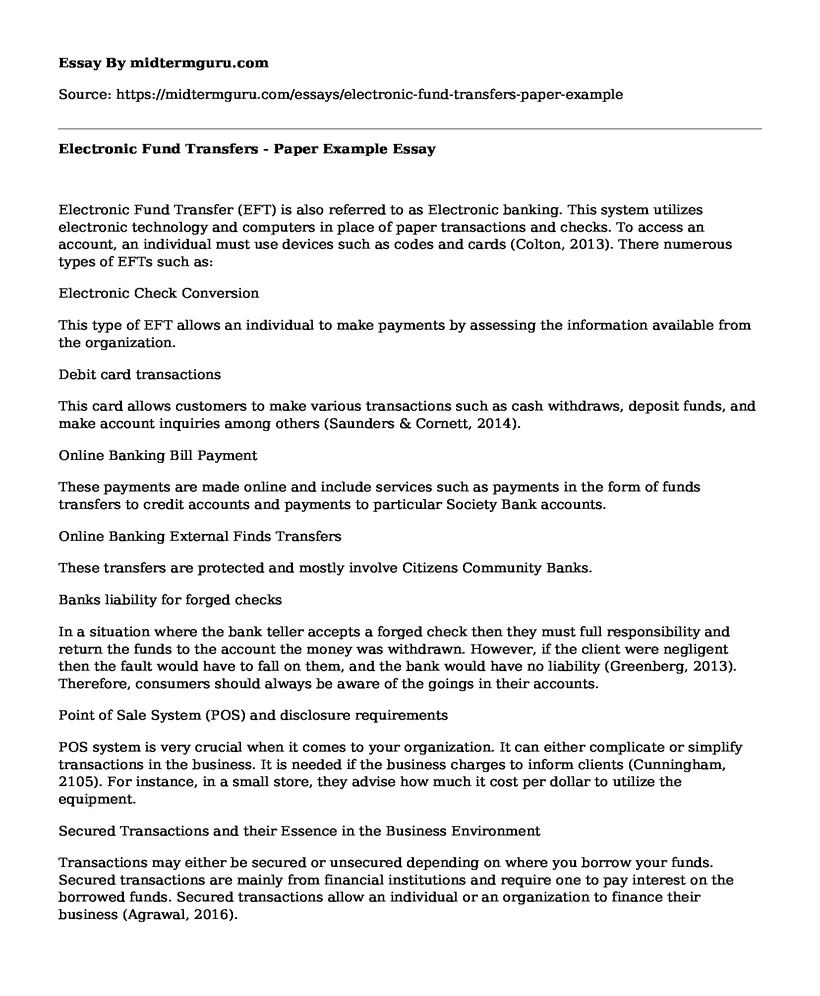Electronic Fund Transfer (EFT) is also referred to as Electronic banking. This system utilizes electronic technology and computers in place of paper transactions and checks. To access an account, an individual must use devices such as codes and cards (Colton, 2013). There numerous types of EFTs such as:
Electronic Check Conversion
This type of EFT allows an individual to make payments by assessing the information available from the organization.
Debit card transactions
This card allows customers to make various transactions such as cash withdraws, deposit funds, and make account inquiries among others (Saunders & Cornett, 2014).
Online Banking Bill Payment
These payments are made online and include services such as payments in the form of funds transfers to credit accounts and payments to particular Society Bank accounts.
Online Banking External Finds Transfers
These transfers are protected and mostly involve Citizens Community Banks.
Banks liability for forged checks
In a situation where the bank teller accepts a forged check then they must full responsibility and return the funds to the account the money was withdrawn. However, if the client were negligent then the fault would have to fall on them, and the bank would have no liability (Greenberg, 2013). Therefore, consumers should always be aware of the goings in their accounts.
Point of Sale System (POS) and disclosure requirements
POS system is very crucial when it comes to your organization. It can either complicate or simplify transactions in the business. It is needed if the business charges to inform clients (Cunningham, 2105). For instance, in a small store, they advise how much it cost per dollar to utilize the equipment.
Secured Transactions and their Essence in the Business Environment
Transactions may either be secured or unsecured depending on where you borrow your funds. Secured transactions are mainly from financial institutions and require one to pay interest on the borrowed funds. Secured transactions allow an individual or an organization to finance their business (Agrawal, 2016).
References
Agrawal, H. O. (2016). An Approach to Business Strategy. Handbook of Research on Promotional Strategies and Consumer Influence in the Service Sector, 154-182.
Colton, K. W. (Ed.). (2013). Computers and banking: electronic funds transfer systems and public policy. Springer Science & Business Media.
Cunningham, C., Good, T., Kearney, S. P., Miraglia, M., Amundsen, T., Giordano, P., ... & Zhu, X. (2015). U.S. Patent No. 8,976,030. Washington, DC: U.S. Patent and Trademark Office.
Greenberg, G. A., & SzE, H. Y. (2013). Ponzi Schemes and Bank Liability: The New Red Flags, the Risks and the Decision Whether To Terminate the Customer Relationship.
Saunders, A., & Cornett, M. M. (2014). Financial institutions management. McGraw-Hill Education.
Cite this page
Electronic Fund Transfers - Paper Example. (2021, Jul 05). Retrieved from https://midtermguru.com/essays/electronic-fund-transfers-paper-example
If you are the original author of this essay and no longer wish to have it published on the midtermguru.com website, please click below to request its removal:
- Essay on One Belt One Road (OBOR)
- Paper Example on Network Security Issues with Wireless Technology
- The Impact of Bank Saving Interest Rate in Banking the Population of Democratic Republic of the Congo: Research Proposal
- The Innovators: A Standard History of the Digital Revolution - Essay Sample
- FDA AERS: Outcome of Adverse Event Reports - Essay Sample
- Data Communication - Essay Sample
- Behavioral Finance: Psychology of Investors and Market Impact - Essay Sample







